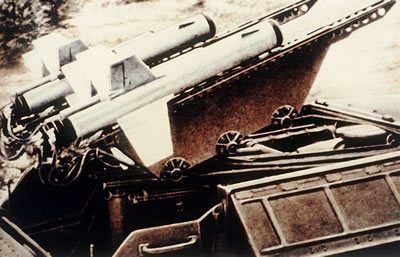The AT-2 Swatter anti-tank guided missile, which was introduced by the Soviet Union in 1960, is one of the earliest of the first generation anti-tank missiles. It uses an MCLOS (Manual Command to Line Of Sight) guidance system. The operator guides the missile to its target using a joystick control.
A variant of the AT-2 Swatter anti-tank missile, the AT-2C Swatter C, uses SACLOS (Semi-Automatic Command to Line of Sight) guidance.
The Swatter weighs 58.4lbs (26.5kg) and is 44.5 inches (1130mm) long. Because it is quite bulky, the AT-2 guided missile is usually mounted on launch rails in banks of four and fired from an AFV. It can be mounted on a helicopter.
 A solid fuel motor propels the AT-2. This anti-tank missile has a flight speed of 335.5 miles per hour (540km/hr). Four stabilizing fins keep the AT-2 on course.
A solid fuel motor propels the AT-2. This anti-tank missile has a flight speed of 335.5 miles per hour (540km/hr). Four stabilizing fins keep the AT-2 on course.
The hollow charge warhead is capable of penetrating up to 19.68 inches (500mm) of armor at a maximum effective range of 1.55 miles (2500m).
There have been three versions of the AT-2: AT-2A Swatter A, which is the original model, AT-2 Swatter B, and AT-2 Swatter C, which uses
AT-2 Swatter is the NATO reporting name for this weapon. Previously, the three versions of the weapon were known by different names. Model AT-2 A, the original version was called the 3M11 Falanga, model AT-2B was called the 9M17 Skorpion and model AT-2C was known as the 9M17 Falanga-M.
The AT-2 Swatter anti-tank missile was used by the Egyptian Army during the 1967 War and by the Iraqi Army during the Iran-Iraq war in the 1980s.